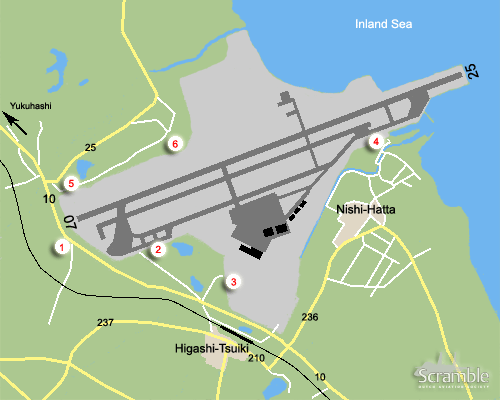1Western approach
Where road nr. 10 crosses the final approach of 07 a minor road leads up the embankment on the western side. Cars can be parked along it once the highest point is reached and this spot is very suitable for viewing and photographing landings on 07. Road 10 is lined by trees on this side so make a choice for the angle you want to shoot at and take position accordingly. Departures from 07 can be read off but are too far away for decent pictures. This spot is close enough to the centreline to use 300mm on average (effective) for fighters. Light is good all day until late afternoon, when the sun starts getting behind the planes on approach.
2Storage
A few F-1s and two T-33s used to be stored on base close to the fence. This spot was accessed via the dead-end street towards some businesses, walking the last part. However, the fence has been replaced by a 20ft wall, blocking the view onto the airfield.
3Main gate
Only one reason to take a look here: preserved aircraft, see panel on the right.
4The quay
One of the most famous aviation photospots in Japan, not just because of the view! This spot offers excellent photo opportunities for aircraft taxiing out to or landing on 25, as well as those airborne from 07 or taxiing in after landing from the west. Even fighters practising strafing runs on the targets next to the runway come into photo-range. Almost any lens will do here, especially for taxi shots. For the runway use about 400mm effective.
What is unique about this location is the quay itself, a concrete wall roughly 5 meters high keeping back the water and following the contour of the airfield. Standing on this wall one has an unobstructed view over the water of the taxiway and checkpoint for 25. No climbing is required from the land-side (just one big step) but this vantage point is not recommended for anyone with fear of heights...
There are alternatives though, a small area next to the wall is 'safer' and a short walk inland along the fence offers other great positions to shoot photos from. Oh yeah, mind the spiders in the trees by the way.
Finding this spot takes some spotters' feel for direction and some perseverance. From the southern tip of the base near Tsuiki Station take the narrow road nr. 236 to Nishi-Hatta. Where this road turns right, keep to the left and enter the village. Try bearing roughly straight ahead, taking very narrow streets in the desired direction. A few graveyards mark the northern edge of Hatta and behind them the channeled stream can be crossed by one of two concrete one-track bridges. The stream ends at a tiny fishing harbour and spot 4 is to the left of that. It used to be possible to park cars directly behind the quay but by the end of 2005 a little more walking was required.
5Northwest side
There are traffic lights where road 25 connects to road 10. Directly after entering 25 keep to the right for the minor road to the crash gate at this end. The track along the fence and graveyards is worth driving to collect numbers from the aprons on the opposite side of the runway where 6 Hikotai is stationed. Photography should be possible here if the light permits so, late in the afternoon or with an overcast ceiling. Also in view are the alert shelters. Reading off planes in those is difficult (assuming they are open at all) but usually aircraft are switched by the end of every day, after flying has finished.
6North side
Proceeding east from spot 5 the road turns away from the base. There is a wooded area here with a shrine and something like a small park. Also, a roadway (usually chained-off) leads towards a small building and an embankment.
In this area, try by foot to get a somewhat better view than elsewhere on the aprons of 304 Hikotai. Again, be aware of spiders.





